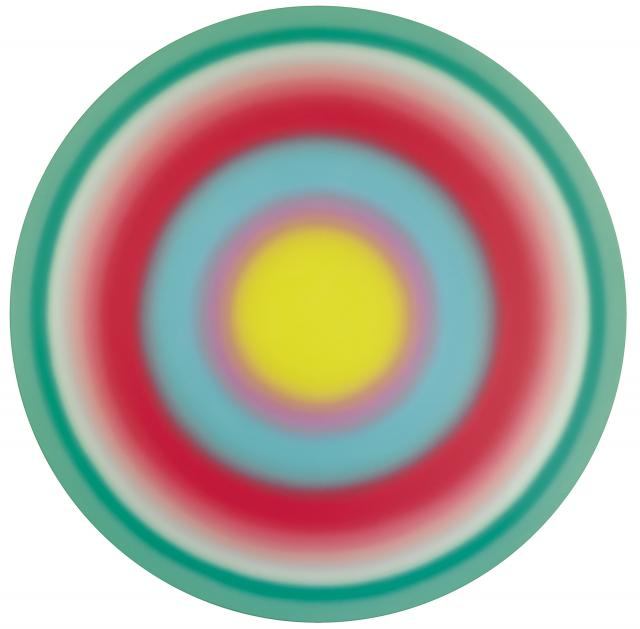In Ugo Rondinone’s body of work, it is possible to work out a certain typology. Several motifs exist, including the door, the clown or mask, and the window, and then there are his immense black-and-white drawings of landscapes, and his constellation paintings.
The most hypnotic of these categories is surely the circular paintings or paintings of targets. On a monumental canvas in the shape of a tondo, Rondinone uses acrylic paint applied in an aerosol spray to form concentric circles in a bright spectrum of colours. The visual result is kinetic, fascinating and magnetic. The motif shimmers and catches the eye, drawing our gaze towards itself and an abyss of optical, physical and mental sensations. Like the psychedelic images of the 1960s or mandala diagrams, the painting transcends its material state to become a support for meditation or spiritual escape.
This serial work – Rondinone often repeats the same subject over and over, though modifying the combination of colours – also suggests a pursuit of passing time, as On Kawara does with his Date Paintings, reiterating the same gestures daily in order to paint the day’s date whilst adhering to similar compositional rules for each picture.
Rondinone’s work gives voice to this obsession with time in a number of ways, notably through the title, which in this case, mirroring Kawara’s practice in his Date Paintings, corresponds to the date the painting was executed. And with his target paintings Rondinone sets up a clear reference to art history. He places his work in the noble genealogy of artists who have also treated the same theme pictorially, Jasper Johns and Kenneth Noland, for instance.
This reference can likewise be read in the colourful treatment of the surface, with the play of diffusion and shimmering of one colour into another recalling the practice of Colour Field artists, a group that included Noland. Yet the radiating nature of the brushstrokes, the fleeting aspect of the colours and the cool, aloof treatment of the subject reveal a spectral appearance of the motif, a far cry from either a strong materialist accent of a Johns, on the one hand, or a geometrical influence of a Noland, on the other.
By creating captivating visual effects, Rondinone seizes on the target – that design of concentric circles which possesses great formal simplicity – and imbues it with a presence that seems to slip away towards the immaterial.
The most hypnotic of these categories is surely the circular paintings or paintings of targets. On a monumental canvas in the shape of a tondo, Rondinone uses acrylic paint applied in an aerosol spray to form concentric circles in a bright spectrum of colours. The visual result is kinetic, fascinating and magnetic. The motif shimmers and catches the eye, drawing our gaze towards itself and an abyss of optical, physical and mental sensations. Like the psychedelic images of the 1960s or mandala diagrams, the painting transcends its material state to become a support for meditation or spiritual escape.
This serial work – Rondinone often repeats the same subject over and over, though modifying the combination of colours – also suggests a pursuit of passing time, as On Kawara does with his Date Paintings, reiterating the same gestures daily in order to paint the day’s date whilst adhering to similar compositional rules for each picture.
Rondinone’s work gives voice to this obsession with time in a number of ways, notably through the title, which in this case, mirroring Kawara’s practice in his Date Paintings, corresponds to the date the painting was executed. And with his target paintings Rondinone sets up a clear reference to art history. He places his work in the noble genealogy of artists who have also treated the same theme pictorially, Jasper Johns and Kenneth Noland, for instance.
This reference can likewise be read in the colourful treatment of the surface, with the play of diffusion and shimmering of one colour into another recalling the practice of Colour Field artists, a group that included Noland. Yet the radiating nature of the brushstrokes, the fleeting aspect of the colours and the cool, aloof treatment of the subject reveal a spectral appearance of the motif, a far cry from either a strong materialist accent of a Johns, on the one hand, or a geometrical influence of a Noland, on the other.
By creating captivating visual effects, Rondinone seizes on the target – that design of concentric circles which possesses great formal simplicity – and imbues it with a presence that seems to slip away towards the immaterial.
